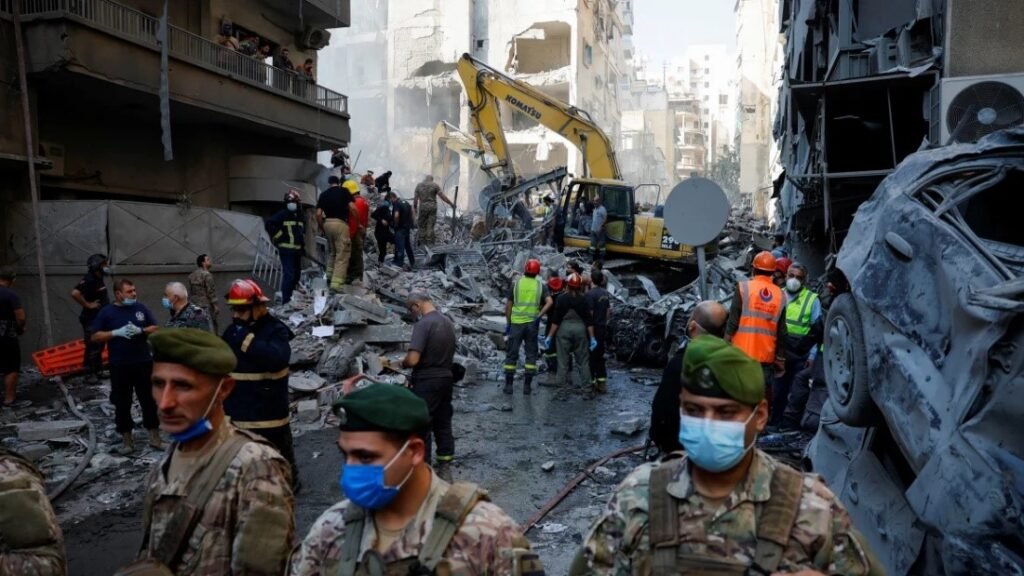Israel’s relentless strikes on Lebanon and Gaza have left thousands dead, millions displaced, and a region grappling with an escalating humanitarian and geopolitical crisis.
Israel’s ongoing massacre in Lebanon and Gaza has left a devastating trail of destruction, escalating violence, and deepening humanitarian crises. The relentless airstrikes have killed thousands, displaced millions, and intensified tensions across the region. This dual-front conflict underscores the grave challenges faced by Lebanon and Palestine, as well as the broader geopolitical and human implications for the Middle East.
Israeli Attack Kills 25 in Lebanon in 24 hours
In Lebanon, Israeli airstrikes have intensified over the past weeks, killing at least 25 people in the latest attacks on Friday and bringing the total death toll to 3,670 (according to Lebanese authorities) since hostilities with Hezbollah reignited over a year ago. These strikes have injured 15,400 people and displaced 1.2 million, according to the Lebanese Health Ministry.

Civil defense members and rescuers work at the site of an Israeli strike in Beirut’s Basta neighborhood (Reuters)
A massive airstrike in Beirut’s Basta district targeted a residential building, reportedly attempting to assassinate a Hezbollah official. The attack destroyed the eight-story building, killing 15 people and injuring more than 60 others, with rescue efforts still underway. The use of “bunker buster” bombs—a hallmark of Israel’s intensified tactics—has drawn sharp criticism from Lebanese authorities and international observers.
According to the Israeli public broadcaster Kan, the attack was an attempt to kill Mohammed Haydar, a top Hezbollah official. Hezbollah MP Amin Sherri said none of the group’s leaders were in the building hit, and Haydar’s fate remained unclear.
“Even if one person is hiding here… Should you destroy buildings where people are sleeping inside? Is it necessary to kill all the people for one person? Or we’re not humans? That’s what I’m asking”- said 55-year-old Ali Nassar, who lived in a nearby building.
Southern Lebanon has also been hit hard. Strikes on Tyre and Ain Baal killed several civilians, including paramedics, raising questions about adherence to international humanitarian law. Despite the destruction, Hezbollah continues its operations, balancing participation in U.S.-mediated ceasefire discussions with a readiness for prolonged conflict.
Over 120 Dead in Palestine in 48 Hours
In the ongoing conflict in Gaza, Palestinian health officials report over 120 deaths in just two days as Israeli airstrikes continue to intensify across the besieged territory. Among these, 7 casualties occurred in a residential area in Gaza City’s Zeitoun suburb, while the remainder were recorded in central and southern Gaza. This violence compounds an already catastrophic toll: since October 2023, Israeli massacre have reportedly claimed over 44,000 lives and injured more than 104,000, according to Palestinian sources.
Significant damage has also been inflicted on key infrastructure, including the al-Faruq Mosque in Nuseirat refugee camp. In northern Gaza, one of the last partially functioning hospitals, Kamal Adwan Hospital, faced direct strikes on its emergency areas, generators, and gates, injuring 12 medical staff, as reported by the hospital’s director, Hussam Abu Safia.

The body of a Palestinian killed in an Israeli strike at Nasser Hospital in southern Khan Younis (Reuters)
Gaza’s Humanitarian Tragedy in Numbers
Since October 2023:
- 44,000+ deaths in Gaza (Palestinian health officials)
- 104,000 injuries among Palestinians
- Over 1,100 deaths in Israel
Humanitarian Catastrophe and Global Solidarity
The violence in Lebanon and Gaza has drawn widespread international condemnation. Defense Secretary Lloyd Austin has urged Israel to alleviate the “dire humanitarian conditions” in Gaza and to pursue a diplomatic resolution in Lebanon. However, diplomatic progress remains limited, with Israel continuing its campaign of massacre and Hezbollah and Hamas engaging in aggressive responses.
The ongoing crisis in Gaza has also sparked global activism and solidarity movements. In the UK, initiatives like “Gaza Cola” have emerged, drawing attention to the plight of Palestinians and advocating for boycotts of companies linked to Israel’s military actions. Such movements echo the growing call for accountability and justice amid the escalating violence.
The economic ramifications are also severe. Lebanon’s fragile economy faces further strain as the conflict disrupts infrastructure and services, while Gaza’s already isolated economy is pushed toward collapse. Regional trade and investment are at risk, amplifying the instability’s impact beyond the immediate conflict zones.
Lastly, Israel’s ongoing massacre in Lebanon and Gaza represents a grave escalation in a conflict that continues to devastate lives and destabilize the region. With thousands dead and millions displaced, the need for immediate humanitarian intervention and a sustainable political resolution has never been more urgent. As the violence persists, the world watches a deepening tragedy that underscores the human and geopolitical cost of unending conflict.


